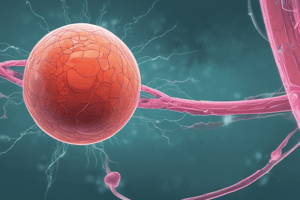Podcast
Questions and Answers
What is one of the major criteria for diagnosing polycythemia vera?
What is one of the major criteria for diagnosing polycythemia vera?
- Subnormal serum erythropoietin level
- Bone marrow fibrosis grade 2–3
- Anemia below the reference range
- Presence of JAK2 p.V617F mutation (correct)
Which of the following is considered a minor criterion for polycythemia vera?
Which of the following is considered a minor criterion for polycythemia vera?
- Trilineage hypercellularity in bone marrow
- Presence of splenomegaly
- Elevated hemoglobin levels
- Subnormal serum erythropoietin level (correct)
What is required to diagnose post-polycythemia vera myelofibrosis?
What is required to diagnose post-polycythemia vera myelofibrosis?
- Current diagnosis of polycythemia vera
- Bone marrow fibrosis of grade 1
- Documentation of a previous diagnosis of polycythemia vera (correct)
- Presence of the JAK2 mutation
In the risk stratification model for polycythemia vera, what age is associated with the highest risk score?
In the risk stratification model for polycythemia vera, what age is associated with the highest risk score?
Which factor contributes 2 points in the MIPSS-PV risk stratification model?
Which factor contributes 2 points in the MIPSS-PV risk stratification model?
What is clonal hematopoiesis?
What is clonal hematopoiesis?
Which mutation is commonly associated with chronic neutrophilic leukemia?
Which mutation is commonly associated with chronic neutrophilic leukemia?
What characterizes age-related clonal hematopoiesis (ARCH)?
What characterizes age-related clonal hematopoiesis (ARCH)?
What condition involves a sustained and unexplained cytopenia without detectable driver mutations?
What condition involves a sustained and unexplained cytopenia without detectable driver mutations?
What is a common clinical presentation of chronic myeloid leukemia?
What is a common clinical presentation of chronic myeloid leukemia?
Which factor often influences the prognosis of chronic neutrophilic leukemia?
Which factor often influences the prognosis of chronic neutrophilic leukemia?
What features characterize polycythemia vera?
What features characterize polycythemia vera?
What is associated with chronic eosinophilic leukemia?
What is associated with chronic eosinophilic leukemia?
What signifies clonal hematopoiesis of indeterminate potential (CHIP)?
What signifies clonal hematopoiesis of indeterminate potential (CHIP)?
What is a common finding in the blood smear of someone with chronic neutrophilic leukemia?
What is a common finding in the blood smear of someone with chronic neutrophilic leukemia?
Flashcards are hidden until you start studying
Study Notes
Myeloid Precursor Lesions
- Clonal hematopoiesis (CH) involves clonal growth of hematopoietic cells originating from affected stem or progenitor cells, irrespective of the underlying cause.
- Age-related clonal hematopoiesis (ARCH) is the presence of clonal hematopoiesis detectable in peripheral blood (PB) or bone marrow (BM) associated with aging, without diagnosis of hematological disorders.
- Clonal hematopoiesis of indeterminate potential (CHIP) is characterized by the detection of somatic mutations in myeloid malignancy genes at a variant allele frequency (VAF) ≥ 2%, without any diagnosed hematologic disorder.
- Clonal cytopenia of undetermined significance (CCUS) features persistent unexplained cytopenias that do not meet criteria for defined myeloid neoplasms.
- Idiopathic cytopenia of unknown significance (ICUS) refers to sustained unexplained cytopenia without identifiable driver mutations associated with blood cancers.
Myeloproliferative Neoplasms
- Chronic Myeloid Leukemia (CML) is marked by splenomegaly, leukocytosis, and a myelocyte bulge with ≥ 20% myeloid blasts or > 5% lymphoid blasts present in the blood.
- Chronic Neutrophilic Leukemia (CNL) may exhibit a myeloid-to-erythroid (M:E) ratio of over 20:1 without fibrosis or dysplasia; commonly involves CSF3RT6181 mutation alongside ASXL1, TET2, or DNMT3A mutations.
- Survival rate for Chronic Neutrophilic Leukemia averages around 2 years, with patients dying from infections, bleeding, or organ failure related to the disease.
- Positive prognostic indicators include the presence of STAT5B p.N642H as the sole mutation, while its combination with other mutations lowers survival (median survival of 14 months).
- Chronic Eosinophilic Leukemia is diagnosed with eosinophils in PB exceeding 1.5 × 10^9/L on at least two occasions and can involve abnormal T-cell populations reflecting lymphocytic variant Hypereosinophilia Syndrome (HES).
Polycythemia Vera (PV)
- Characterized by erythrocytosis, often alongside leukocytosis and thrombocytosis, typically associated with activating JAK2 mutations.
- Diagnostic criteria include meeting either all three major criteria or the first two major plus one minor criterion:
- Major: Elevation of hemoglobin (≥ 16.5 g/dL in men, ≥ 16.0 g/dL in women) or hematocrit (≥ 49% in men, ≥ 48% in women); trilineage hypercellularity in bone marrow with marked erythroid and myeloid proliferation; presence of JAK2 p.V617F or exon 12 mutation.
- Minor: Subnormal serum erythropoietin levels.
- Criteria for diagnosing post-polycythemia vera myelofibrosis include prior PV diagnosis and grade 2–3 bone marrow fibrosis.
- Additional diagnostic indicators may include anemia, leukoerythroblastosis, splenomegaly, and constitutional symptoms such as significant weight loss or fever.
PV Risk Factors
- Risk stratification includes age, venous thrombosis, and leukocytosis to predict survival outcomes, with the Mayo Clinic identifying significant associations:
- Age ≥ 67 years: 5 points, age 57–66 years: 2 points, presence of venous thrombosis: 1 point, leukocytosis (≥ 15 × 10^9/L): 1 point.
- Survival outcomes based on stratification:
- High-risk (≥ 3 points): median survival around 9.6 years.
- Intermediate risk (1-2 points): median survival approximately 18 years.
- Low risk (0 points): median survival extending to 28 years.
Studying That Suits You
Use AI to generate personalized quizzes and flashcards to suit your learning preferences.



